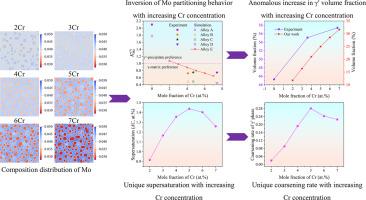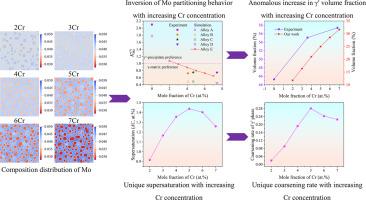New insights into the partitioning behavior of Mo in nickel-based superalloys and its effect on microstructure using CALPHAD-assisted phase field modeling
IF 8.3
1区 材料科学
Q1 MATERIALS SCIENCE, MULTIDISCIPLINARY
引用次数: 0
Abstract
Elemental partitioning behaviors are critical in determining the high-temperature capabilities of superalloys. In multi-component superalloys, these behaviors are influenced by the competition among elements. This study examines the effects of Cr concentration on elemental distribution behaviors and γ′ evolution in Ni–10Al–4Mo–xCr superalloys using CALPHAD-informed phase field modeling. Our simulations show that Mo's preference shifts from γ′ precipitates to γ matrix as Cr concentration increases. This shift results from the competitive interactions between Mo and Cr atoms at the corner sites of Ni3Al, reducing Mo's solubility in γ′ precipitates. Further analysis reveals that with increasing Cr concentration, more Mo is displaced by Cr at the B sites of γ′-A3B. Additionally, the Mo content in γ′ precipitate decreases with rising Cr content, resulting in an abnormal rise in the γ′ volume fraction based on Mo mass balance. Moreover, γ′ coarsening rate initially rises and then falls with increasing Cr concentration in an inverted “V” shape, a change attributable to variations in the γ matrix supersaturation. These findings provide new insights into Mo distribution in nickel-based superalloys and offer guidance for designing superalloys with improved microstructural stability.


利用 CALPHAD 辅助相场建模对镍基超合金中钼的分配行为及其对微观结构影响的新认识
元素分配行为是决定超级合金高温性能的关键。在多组分超耐热合金中,这些行为受到元素间竞争的影响。本研究采用 CALPHAD 为基础的相场建模,研究了铬浓度对 Ni-10Al-4Mo-xCr 超合金中元素分布行为和 γ′ 演变的影响。模拟结果表明,随着铬浓度的增加,钼的偏好从γ′沉淀转移到γ基体。这种转变是由于镍3Al角位上的钼原子和铬原子之间的竞争性相互作用降低了钼在γ′沉淀中的溶解度。进一步的分析表明,随着铬浓度的增加,γ′-A3B 的 B 位上有更多的钼被铬取代。此外,γ′沉淀中的钼含量随着铬含量的增加而减少,导致基于钼质量平衡的γ′体积分数异常上升。此外,随着铬浓度的增加,γ′粗化率先上升后下降,呈倒 "V "形,这种变化可归因于γ基体过饱和度的变化。这些发现为了解镍基超合金中 Mo 的分布提供了新的视角,并为设计具有更好微观结构稳定性的超合金提供了指导。
本文章由计算机程序翻译,如有差异,请以英文原文为准。
求助全文
约1分钟内获得全文
求助全文
来源期刊

Acta Materialia
工程技术-材料科学:综合
CiteScore
16.10
自引率
8.50%
发文量
801
审稿时长
53 days
期刊介绍:
Acta Materialia serves as a platform for publishing full-length, original papers and commissioned overviews that contribute to a profound understanding of the correlation between the processing, structure, and properties of inorganic materials. The journal seeks papers with high impact potential or those that significantly propel the field forward. The scope includes the atomic and molecular arrangements, chemical and electronic structures, and microstructure of materials, focusing on their mechanical or functional behavior across all length scales, including nanostructures.
 求助内容:
求助内容: 应助结果提醒方式:
应助结果提醒方式:


